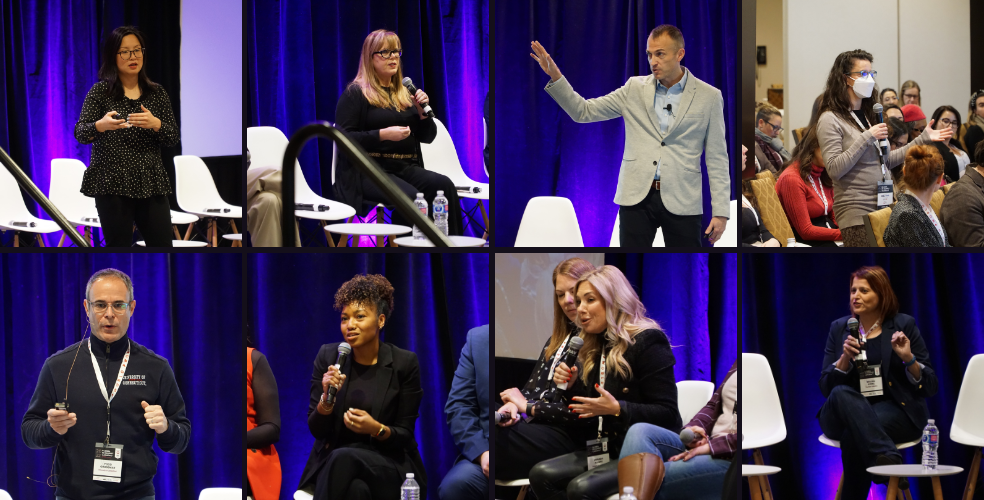 November 23, 2022
November 23, 2022

Uncertainty is the "new normal": Notes from the Global PR Summit Canada 7
December 14, 2022
The 7th edition of the Global PR Summit Canada in Toronto attracted over 200 delegates and 40 speakers, providing an insightful look at today's changing PR industry trends and challenges. From purpose, attracting the right talent and diversity to content PR, online communities and polarization, the Summit highlighted the changing landscape of the industry and the steps that PR professionals need to take in order to protect the reputation of their organizations in today's competitive environment. To assist you in creating your PR plan for 2023, we are sharing with you the most important things we learned at the Summit, in the hope that this will assist you in preparing a communication strategy for what will no doubt be an "interesting" year.
Uncertainty is the New Normal
The expectation of companies today is that they will stand up and take political risks. In her keynote address, Shaila from BcW Global stressed that corporate social responsibility has evolved beyond environmental commitments to active expectations on issues that do not directly relate to brands and that lobbying on a particular issue or contributions are no longer sufficient.
There is a lot of talk about "embracing" or "leaning into" uncertainty. Public relations professionals do not have any other choice. We are all asking ourselves, is constant anxiety really the brand-new normal? Is it possible to find those opportunities to tell our story as well? In addition, we must recognize that uncertainty has changed the nature of crisis communications. As a result, escalation is occurring more rapidly, reactions are more extreme, the impact is broader, demand for action is greater, and recovery is more difficult. Preparation is crucial in this type of environment. In this regard, what are the steps that you need to take?
- Assess risks: Conduct crisis audits, create stakeholder maps, analyze existing capabilities against needs, and create actionable recommendations.
- Designate crisis teams: Establish an optimal organizational structure, define clear roles and processes, and hold regular meetings regardless of the situation.
- Review your crisis manuals: Create a blueprint for action, including roles, escalation protocols, guidelines and templates. Maintain a current briefing book and plan for high-priority risks
- You should build your team's competency through crisis simulations, adjust systems and tools as necessary, and ensure that key spokespersons are continuously media trained and remain current.
In order to remain resilient and agile, you must embrace uncertainty and use it to your advantage. Be prepared to be a faster learner, to measure everything and to understand your environment and competitors.
Purpose is Everything!
Increasing polarization in the world makes your organization's purpose more crucial than ever before. Consumers are 4x more likely to purchase from a brand with a purpose and 4.5x more likely to recommend the brand to their friends and family, according to a 2020 Zeno Strength of Purpose study. In addition, a study by Accenture found that 66% of consumers would switch from a product they typically buy to one from a purpose-driven brand. It is important to note that purpose-driven PR does not only refer to marketing campaigns and promotional materials, but rather to a way of thinking that is shared throughout an organization.
How do you create a PR strategy that is authentic and purpose-driven? According to Solenne from L’Oreal Canada, first of all, you need to understand that purpose is determined more by actions than by words. To communicate an authentic purpose, you must embody tangible actions, provide proof points, and most importantly, be transparent. In order to develop a PR strategy that is purpose-driven, employees should be at the center and consumers should be your advocates.
Taking an Inclusive Approach to Public Relations
According to Salesforce, inclusive content is "content that reflects the diverse communities our companies serve.". It means that we are elevating diverse voices and role models, decreasing cultural bias, and leading positive social change through thoughtful and respectful content.”
As an organization, you should develop your own definition of inclusive content that is based on your mission statement. According to diversity and inclusion consultant Prasanna Ranganathan, when creating an inclusive content framework, you should ask yourself a few questions:
- Who is represented in this content?
- What is the core message of this content?
- Who can access this content?
- What does this content say about your brand and what it believes in?
- Who is creating this content?
Lastly, for a successful DEIB strategy, you should incorporate storytelling and develop systems and processes for all stages. A key component of inclusive content involves hiring and building a diverse and inclusive team, not just checking boxes.
Prepare for Cyber Security Incidents
It still surprises us that many organizations do not include cyber incidents in their crisis plans. According to Ashley Korte from Equifax, only 50% of U.S. businesses have a cybersecurity plan in place, and 30% of executives claim their budgets are insufficient for adequate security. In an era in which data is everything, these figures may seem a bit depressing. In an age when cyber-attacks are on the rise, how can your reputation be protected? It's all about the 5C's of crisis management.
- Culture: Security First Mindset/ Shared Responsibility / Accountability
- Communication: Be Transparent/ Be Proactive/ Be Receptive
- Collaboration: Share Resources/ Develop Insight / Create Cohesion
- Consistency: Establish Awareness/ Provide Stability / Build Trust
- Commitment: Drives Strategy/ Enhances Performance/ Improves Culture
Content is King, Context is Queen
Content overload is a prevalent phenomenon in our day and age. On a daily basis, PR professionals are faced with the challenge of creating original content. What are the characteristics of a high-quality piece of content? According to Andy Fuller of University of Notre Dame, content is a contract where both parties contribute and expect a return. The audience has invested time and deserves a positive return on investment, and you are either seeking to inform or influence them. A great story should have a character, setting, plot, conflict and a resolution. As part of your storytelling approach, you should identify work that speaks to the priorities of your brand, layer the elements, produce and distribute it. But context is queen! It is always important to consider the following factors when producing content:
Channel Context
Is the content appropriate for the channel?
Organizational Context
Where you are in the life of your business
Do you have permission to tell this story?
Social Context
Where you are in the life of the world
Is it the right time to tell the story?
Customer Context
Where you are in the life of your customer
How are you instilling trust?
The following are the most important points to keep in mind when developing a content PR strategy:
- Your brand lives in the hearts and minds of your customers.
- We inform with facts. We influence with emotions.
- Storytelling gives you the best chance to influence your audience.
- Good storytellers understand context.
Despite the gloomy outlook, communications professionals have demonstrated flexibility in adapting to challenging circumstances over the past three years. I am confident that we will also be able to overcome the challenges that lie ahead.
As a result of what has happened around us in the past few years, communications professionals have finally cemented their position as reputation guardians. It is no longer necessary to fight for a seat at the table. It is fair to say that the table would not exist in this brand new reality without the communications team.
In what ways are you preparing for 2023? You are welcome to share your thoughts with us.